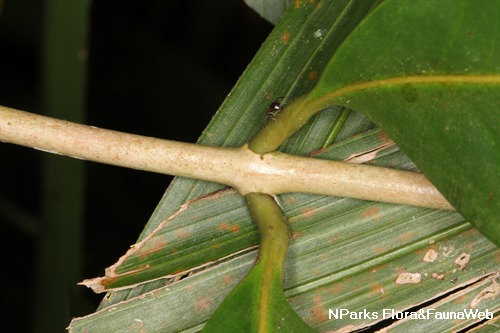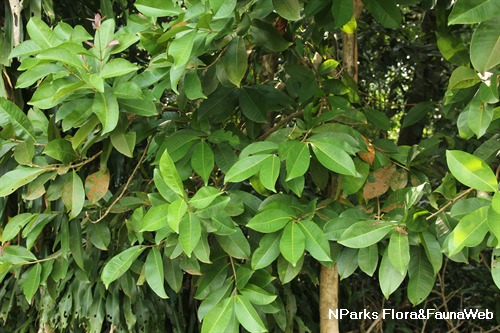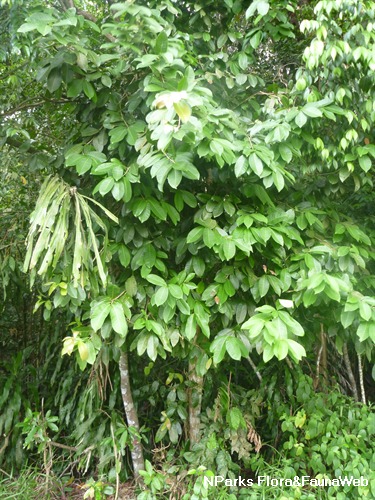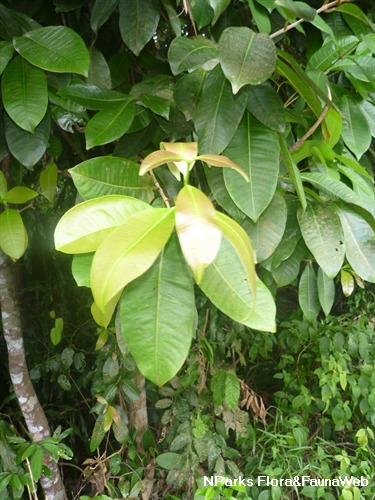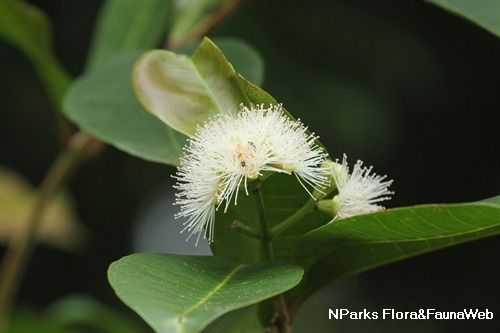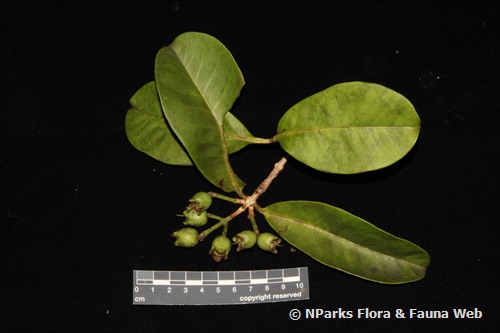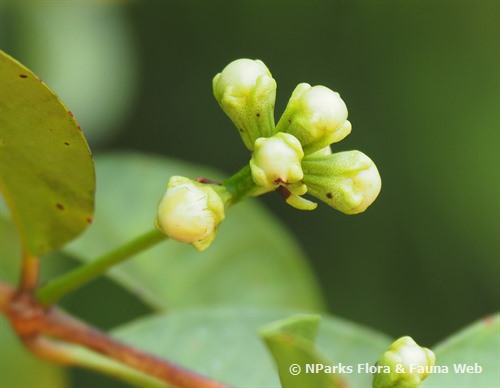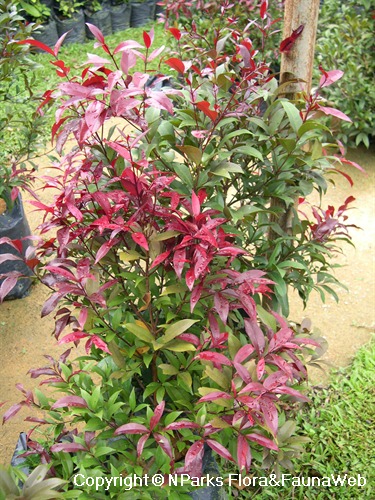
Back
Syzygium pachyphyllum (Kurz) Merr. & L.M.Perry
| Family Name: | Myrtaceae |
| Common Name: | Thick-leaved Jambu, Kelat |
Name
Classifications and Characteristics
| Plant Division | Angiosperms (Flowering Seed Plants) (Dicotyledon) |
|---|---|
| Plant Growth Form | Tree (Small (6m-15m)) |
| Lifespan (in Singapore) | Perennial |
| Mode of Nutrition | Autotrophic |
| Plant Shape | Irregular |
| Maximum Height | 15 m |
Biogeography
| Native Distribution | From Myanmar, through Thailand, Peninsular Malaysia, Singapore to Borneo. |
|---|---|
| Native Habitat | Terrestrial (Primary Rainforest, Secondary Rainforest, Freshwater Swamp Forest, Riverine) |
| Preferred Climate Zone | Tropical, Sub-Tropical / Monsoonal |
| Local Conservation Status | Native to Singapore (Critically Endangered (CR)) |
Description and Ethnobotany
| Growth Form | It is a tree that can grow up to 15 m tall with whitish flaky twigs. |
|---|---|
| Foliage | Its opposite, stalked leaves have leathery leaf blades that are drop-shaped and 6–20 cm by 2–8.5 cm. Each leaf blade has a shortly pointed or blunt tip, 1 vein running parallel to the blade margin, and 9–15 pairs of side veins. |
| Flowers | Its bisexual flowers are white, 1.9–3.2 cm across, and found in up to 17-cm long flower clusters located at the ends of its twigs or axils of its leaves. |
| Fruit | Its fleshy fruits are round or drop-shaped, green, 1.8–2.5 cm long by 2 cm wide, and contain 1–2 seeds each. |
| Habitat | It grows in lowland forests and rice fields, often near streams. |
| Associated Fauna | Its flowers are probably pollinated by bats. |
| Cultivation | It can be propagated by seed. |
| Etymology | Greek syzygos, joined, referring to the paired leaves of this species; Greek pachyphyllum, thick leaf |
Landscaping Features
| Landscaping | It is suitable for parks and streetscapes for its bushy crown and attractive white powder-puff like flowers. |
|---|---|
| Desirable Plant Features | Ornamental Flowers, Ornamental Form |
| Landscape Uses | Suitable for Roadsides, Parks & Gardens |
Fauna, Pollination and Dispersal
| Pollination Method(s) | Biotic (Fauna) |
|---|---|
| Seed or Spore Dispersal | Biotic (Fauna) |
Plant Care and Propagation
| Light Preference | Full Sun |
|---|---|
| Water Preference | Lots of Water, Moderate Water |
| Plant Growth Rate | Moderate |
| Rootzone Tolerance | Moist Soils, Waterlogged Soils (Drains Site), Well-Drained Soils |
| Maintenance Requirements | Moderate |
| Propagation Method | Seed |
Foliar
| Foliage Retention | Evergreen |
|---|---|
| Mature Foliage Colour(s) | Green |
| Mature Foliage Texture(s) | Leathery, Thick |
| Foliar Type | Simple / Unifoliate |
| Foliar Arrangement Along Stem | Opposite |
| Foliar Attachment to Stem | Petiolate |
| Foliar Shape(s) | Non-Palm Foliage (Obovate) |
| Foliar Venation | Pinnate / Net |
| Foliar Margin | Entire |
Floral (Angiosperm)
| Flower & Plant Sexuality | Bisexual Flowers |
| Flower Colour(s) | Cream / Off-White, White |
|---|---|
| Flower Grouping | Cluster / Inflorescence |
| Flower Location | Axillary, Terminal |
| Flower Symmetry | Radial |
Fruit, Seed and Spore
| Mature Fruit Colour(s) | Green |
|---|---|
| Fruit Classification | Simple Fruit |
| Fruit Type | Fleshy Fruit , Non-Accessory Fruit |
Image Repository
Others
| Master ID | 29844 |
|---|---|
| Species ID | 4153 |
| Flora Disclaimer | The information in this website has been compiled from reliable sources, such as reference works on medicinal plants. It is not a substitute for medical advice or treatment and NParks does not purport to provide any medical advice. Readers should always consult his/her physician before using or consuming a plant for medicinal purposes. |

